
The Araceae are a family of monocotyledonous flowering plants in which flowers are borne on a type of inflorescence called a spadix. The spadix is usually accompanied by, and sometimes partially enclosed in, a spathe. Also known as the arum family, members are often colloquially known as aroids. This family of 140 genera and about 4,075 known species is most diverse in the New World tropics, although also distributed in the Old World tropics and northern temperate regions.

In botany, a spadix is a type of inflorescence having small flowers borne on a fleshy stem. Spadices are typical of the family Araceae, the arums or aroids. The spadix is typically surrounded by a leaf-like curved bract known as a spathe. For example, the "flower" of the well known Anthurium spp. is a typical spadix with a large colorful spathe.

Philodendron is a large genus of flowering plants in the family Araceae. As of September 2015, the World Checklist of Selected Plant Families accepted 489 species; other sources accept different numbers. Regardless of number of species, the genus is the second-largest member of the family Araceae, after genus Anthurium. Taxonomically, the genus Philodendron is still poorly known, with many undescribed species. Many are grown as ornamental and indoor plants. The name derives from the Greek words philo- 'love, affection' and dendron 'tree'. The generic name, Philodendron, is often used as the English name.

Spathiphyllum is a genus of about 47 species of monocotyledonous flowering plants in the family Araceae, native to tropical regions of the Americas and southeastern Asia. Certain species of Spathiphyllum are commonly known as spath or peace lilies.

Zantedeschia is a genus of eight species of herbaceous, perennial, flowering plants in the aroid family, Araceae, native to southern Africa. The genus has been introduced, in some form, on every continent.
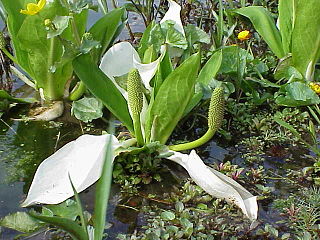
Lysichiton is a genus in the family Araceae. These plants are known commonly as skunk cabbage or less often as swamp lantern. The spelling Lysichitum is also found. The genus has two species, one found in north-east Asia, the other in north-west America.
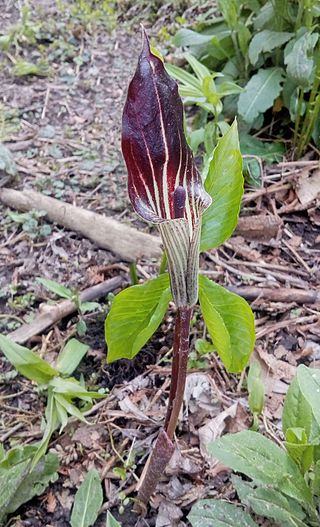
Arisaema triphyllum, the Jack-in-the-pulpit, is a species of flowering plant in the arum family Araceae. It is a member of the Arisaema triphyllum complex, a group of four or five closely related taxa in eastern North America. The specific name triphyllum means "three-leaved", a characteristic feature of the species, which is also referred to as Indian turnip, bog onion, and brown dragon.

Zamioculcas is a genus of flowering plants in the family Araceae, containing the single species Zamioculcas zamiifolia. It is a tropical herbaceous perennial plant, native to eastern Africa including Kenya, KwaZulu-Natal, Malawi, Mozambique, Tanzania, and Zimbabwe. Common names include Zanzibar gem, ZZ plant, Zuzu plant, aroid palm, eternity plant and emerald palm. It is grown as a houseplant mainly for its attractive glossy foliage and easy care. Zamioculcas zamiifolia is winter hardy to USDA Zones 9–10.

Arum is a genus of flowering plants in the family Araceae, native to Europe, northern Africa, and western and central Asia, with the highest species diversity in the Mediterranean region. Frequently called arum lilies, they are not closely related to the true lilies Lilium. Plants in closely related Zantedeschia are also called "arum lilies".
Carlephyton is a genus of four species in the family Araceae, all endemic to Madagascar.

Callopsis is a monotypic genus from the plant family Araceae and has only one species, Callopsis volkensii. This plant forms a creeping rhizome and has cordate-ovate leaves that are medium green and glabrous. The inflorescence is typical of the family Araceae, with a white spathe and yellow spadix. The spadix is shorter than the spathe and its male and female flowers are separated shortly.
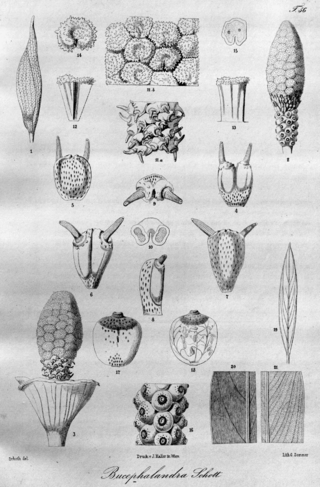
Bucephalandra is a genus of flowering plants in the family Araceae. There are 30 species of Bucephalandra which have been discovered in Borneo and have been formally described by S.Y. Wong and P.C. Boyce. Most of the species are found in Borneo. Bucephalandra are usually found growing as dense mats over stones or rocks in streams or rivers in moist tropical forest.

Holochlamys is a monotypic genus of flowering plants in the family Araceae. Holochlamys beccarii is the only species in the genus Holochlamys. It is native to New Guinea and the Bismarck Archipelago and is found growing in mud near lowland streams or rocky streambeds at high elevations.

Lagenandra is a genus of flowering plants in the family Araceae. It is endemic to the Indian Subcontinent. The genus is similar to Cryptocoryne, but can be distinguished from it by its involute vernation. Cryptocoryne on the other hand exhibit convolute vernation.
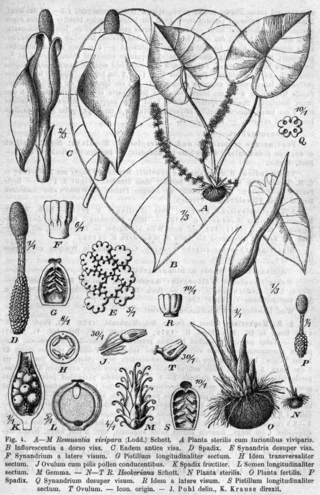
Remusatia is a genus of flowering plants in the family Araceae. It contains 4 known species, one of which was described in 1987. This species was initially placed in genus Gonatanthus called Gonatanthus ornatus. After the genus had been sunk into Remusatia its new name was Remusatia ornatus, but it was later changed to Remusatia hookeriana.

Anthurium andraeanum is a flowering plant species in the family Araceae that is native to Colombia and Ecuador. It is a winner of the Royal Horticultural Society's Award of Garden Merit.

Thaumatophyllum xanadu is a perennial plant belonging to the arum family Araceae and the genus Thaumatophyllum, formerly classified under the Meconostigma subgenus of Philodendron. This plant is native to Brazil, but is widely cultivated as a landscape plant in tropical, subtropical and warm temperate climates.

Anthurium clarinervium is a species of flowering plant is in the family Araceae native to Chiapas, Mexico. The Anthurium genus is known to contain approximately 1,000 species, resulting in one of the most diverse Central American tropical plant genera.
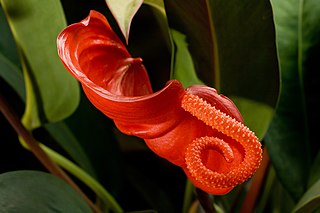
Anthurium scherzerianum, the flamingo flower or pigtail plant, is a species of Anthurium native to Costa Rica. It has gained the Royal Horticultural Society's Award of Garden Merit as an ornamental houseplant, kept at 15 °C (60 °F) or higher. It is naturally an epiphyte, growing on trees in the rainforest.
Thaumatophyllum adamantinum is a plant in the genus Thaumatophyllum, in the family Araceae. It is native to South America, namely to Southeast Brazil, but is also cultivated as a houseplant in cooler climates.




























